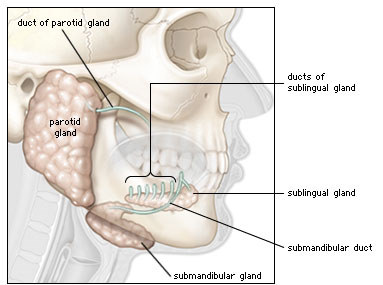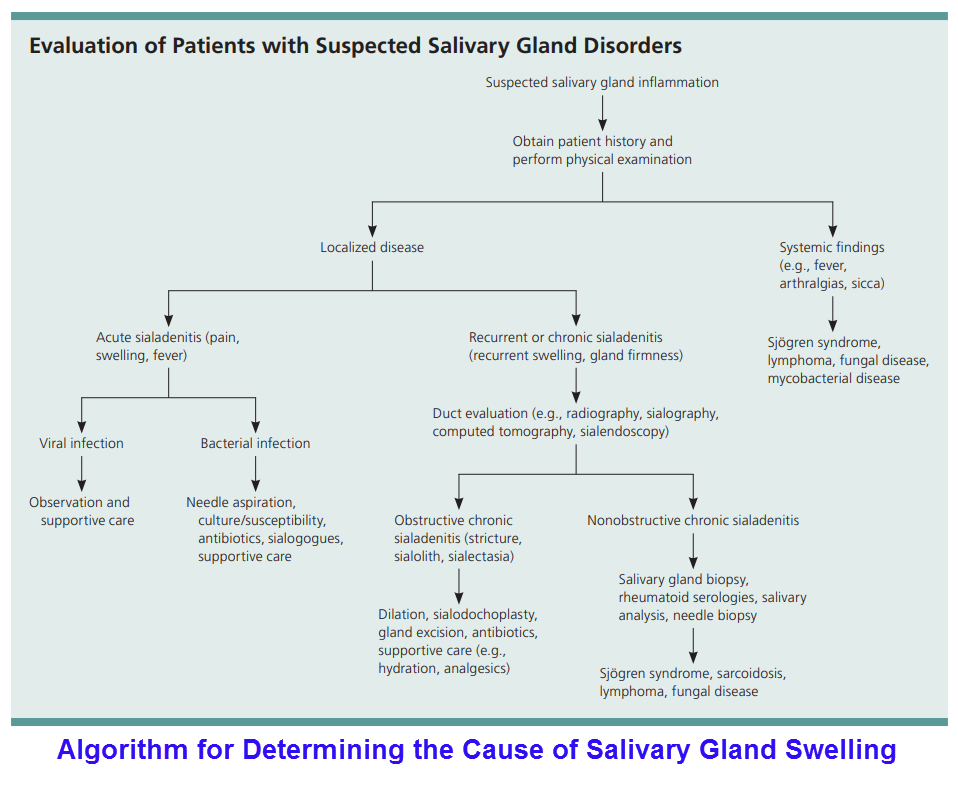Salivary Gland Disorders

Salivary gland diseases are multiple and varied in cause. Salivary gland disorders include inflammatory, bacterial, viral and neoplastic causes.
Their presentation can be acute, recurrent or chronic.
The function of the salivary glands is to secrete saliva, which has a lubricating function, which protects the oral mucosa of the mouth during eating and speaking.
Saliva also contains digestive enzymes (e.g. salivary amylase) and has anti-microbial action and acts as a buffer.
Salivary gland dysfunction occurs when salivary rates are reduced and this can result in xerostomia (dry mouth).
The most common disorders of salivary glands involve mucous cysts, blockage by calcified stones, infection and abnormal growths. Various examples of disorders affecting the salivary glands are listed below.
Sialadenitis is inflammation of a salivary gland, usually caused by infections, although there are other less common causes of inflammation such as irradiation, allergic reactions or trauma.
Acute suppurative sialadenitis presents as rapid-onset pain and swelling and is treated with antibiotics, salivary massage, hydration and sialagogues (agents that increase the secretion of saliva) such as lemon drops or vitamin C lozenges.
Viral causes include Mumps and Human Immunodeficiency Virus and treatment is directed at the underlying disease.
Recurrent or chronic sialadenitis is more likely to be inflammatory than infectious; examples include recurrent parotitis of childhood and sialolithiasis (salivary stones).
Inflammation is commonly caused by an obstruction such as a stone or duct stricture. Management is directed at relieving the obstruction.
Benign and malignant tumours can occur in the salivary glands and usually present as a painless solitary neck mass. Diagnosis is made by imaging (e.g., ultra-sonography, computed tomography, magnetic resonance imaging) and biopsy (initially with fine-needle aspiration). Overall, most salivary gland tumours are benign and can be treated with surgical excision.

Useful Books
Salivary Gland Diseases. Surgical & Medical Management 2005
Textbook & Color Atlas of Salivary Gland Pathology. Diagnosis & Management 2008
Salivary Gland Pathology. Diagnosis & Management. 2nd Edition. 2016
Atlas of Salivary Gland Pathology 2019
Useful Articles & Websites
Dental Update 1999. Oro-Facial Disease. Update for the Dental Clinical Team. 8. Salivary Complaints
Oral Diseases 2002. Diagnosing, Managing & Preventing Salivary Gland Disorders
Oral Diseases 2002. Saliva – The Defender of the Oral Cavity
Oral Diseases 2002. Saliva as a Diagnostic Fluid
Oral Diseases 2002. Salivary Gland Tumours
Oral Diseases 2010. Salivary Glands – “An Unisex Organ”?
BMJ 2012. Clinical Review. Salivary Gland Swellings
Dental Update 2012. Oral Medicine 4. Dry Mouth & Disorders of Salivation
Dent Update 2013. Oral Medicine 12. Lumps & Swellings – Salivary
Am Fam Physician 2014. Salivary Gland Disorders
World J Stomatol 2015. Salivary Gland Disorders – A Comprehensive Review
Oral Maxillofacial Surg Clin N Am 2009. Epidemiology_of_Salivary_Gland_Infection
Burket’s Oral Medicine, Diagnosis & Treatment, 10th Edition. Chapter 9, Salivary Gland Disease
